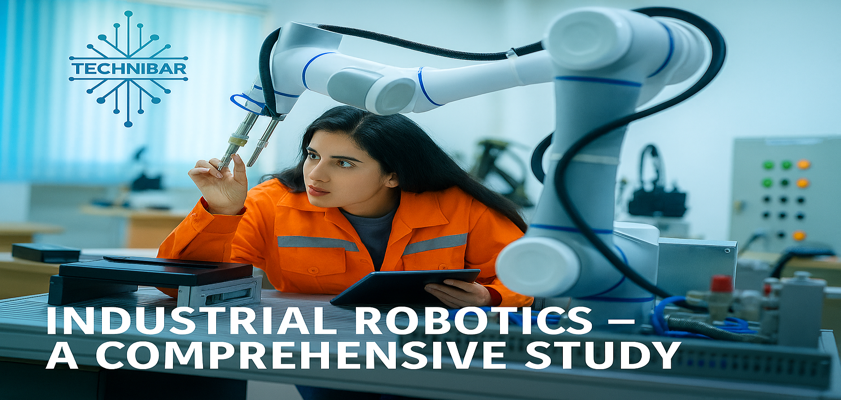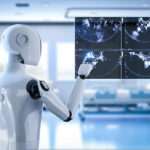Robotics is the second most upheaving technology of the 21 st century. It is a cross-disciplinary field between mechanical engineering and electrical engineering and computer science, artificial intelligence (AI) and sensor technology. The final goal of robotics is the design of machines capable of performing with an accuracy level, intelligence, and flexibility of people. Industrial robotics has changed the manner in which factories and production systems are handled. The main aim of industrial robots is to automate tasks that are repetitive, dangerous or complex in the manufacturing environment. Industrial robots are transforming manufacturing today not only in how but also in what business entities perform. Robots are integrated into almost all sectors including the automobile assembly line, pharmaceutical packaging, etc.
The value of Robotics
Early man had always innovated tools so the work could be physical less and productivity high. The industrial revolutions of the past mechanized the production of goods, whereas subsequent revolutions introduced electricity and electronics, and computing in industries. Robotics is the fourth industrial revolution (Industry 4.0), in which machines not only serve as a tool, but rather smart partners.
The relevance of industrial robotics can be summed as:
Speed and Productivity
Robots do not always need to work at full efficiency as employees do hence can work 24/7.
Accuracy and Consistency
They do not make mistakes when practicing a task.
Safety
Robots are used as a substitute to humans in hazardous working conditions (hazardous materials, hot conditions, radioactivity).
Cost-Effective
Though expensive at first, they can lessen the costs of labor and make mistakes in the long term.
Scalability
They enable industries to boost production and not the workforce accordingly.
History and development of Robotics
The idea of automatic machines is old.
Historical milestones
There are historical milestones in connection with the origins of the word.
Greco-Roman
World Ancient Greece Hero of Alexandria invented water powered automata.
Trajan tries to taste water-powered clocks
Al-Jazari quite ingeniously designed the water powered clocks and automatons.
The 1950s
George Devol and Joseph Engelberger invented Unimate, which is the first industrial robot, operating in the factory of General Motors to do the job of welding.
1970s-1980s
Robotic mass production was started in Japan, mostly by companies such as FANUC and Kawasaki.
1990s-2000s
Computing and AI were developed, along with miniaturization enabling the robots to be speedier and smarter.
The post-2010s
AI, IoT, cloud computing and machine vision now allowed industrial robots to train and adapt and work collaboratively with humans.
The Present Destiny of the Industrial Robotics
Industrial robots are categorized into a number of divisions in terms of design and application. Market leaders in the production of robots include FANUC, ABB, KUKA, Yaskawa, Mitsubishi and Universal robots.
Important Robots Applications
Automobile Manufacturing
- Welding auto bodies
- Very precise painting.
- The putting together of hard and sensitive parts.
Electronics Industry
- Putting together microchips, smart phones and laptops.
- Robotic arms are used to handle delicate parts.
Pharmaceutical And Food Industries
- Automatic packaging and seals.
- Machine vision on quality inspection
- High speed filling, sorting and labeling.
Powders and Cosmetics Cosmetics and Consumer Goods
- Automated bottling labeling.
- Ensuring production lines to be hygienic.
The types of industrial robotics include the following:
Articulated Robots
- It looks like an extension of a human arm with several joints.
- Universal in welding, coloring and assembly.
All SCARA Robots (Selective Compliance Assembly Robot Arm)
- Operate in horizontal movements.
- Applications in the assembly of small electronics, packaging and material handling.
Delta/Parallel Robots
- Three or more-arm robots, mounted on a base and operating as fast as possible.
- Suited to use in pick-and-place (e.g. food packaging).
Cobots: Collaborative Robots
- Engineered to operate around people.
- They have been fitted with high quality sensors to avoid accidents.
- A programmable system that is applied in mini corporations and flexible production systems.
Controls in Robotics
Industrial robots depend on a high technology of control to operate. The most important technologies are:
Kinematics and Dynamics
The mathematical rules to compute robot positioning in relation to positioning.
Interpolation
Smooth path planning precision movement.
Sensing Technology
The camera, LIDAR, forces sensors to detect the status of objects and obstacles.
Machine Vision
This allows robots to perceive and adapt on the fly.
Digital Twin Technology
Modeling of robots prior to sending them out into the physical world.
Benefits of Industrial Robotics
Productivity
No rest in between work.
Quality
Deficiencies are diminished by structured output.
Flexibility
Can be programmed with ease to suit other tasks.
Safety at the work place
Minimizes danger of humans to harmful tasks.
Difficulties and Shortcomings
High Capital Cost
costly installation and setup.
Job-Displacement
Decreased requirement of unskilled workers.
Maintenance Costs
This will need competent engineers to maintain.
Cybersecurity Risks
Could be hacked when connected to the IoT systems.
Robotics and the World Labor Force
Through industrial robotics, there is a two-fold effect on labor:
Job Displacement
This is due to linear manual processes that are being replaced by automation.
Generation of employment
Emerging new jobs will be in the areas of programming, maintenance, AI, robotics engineering.
For example:
- The robots already operate in material handling in Amazon warehouses, still, human employees are necessary in the quality control and logistics.
- Tesla uses robotics in its Gigafactory as the assembly lines and are totally dependent on humans; however, these human beings are engineers who oversee, program, and repair the robotics.
Other Uses than Manufacturing
Though it is mainly associated with factories, robotics has found its way to other disciplines:
Healthcare Robotics
- Robot systems (e.g. da Vinci Surgical System) during surgery.
- Automatic dispensing of drugs.
Military Robotics
- Drones.
- Bomb bots.
Space Exploration
- Martian vehicles (rarity, dedication).
- Experimental robotic arms at the International Space Station.
Agriculture Robotics
- Autonomous Tractors and Drones to monitor crops.
- The use of robo-harvesters on fruits and vegetables.
Industrial Robotics of the Future
In the future industrial robotics will become a reality.
More Autonomous
AI enables us to make decisions.
More Cooperative
Easily integrating with people in mixed work environments.
More cost effective
Dawn of smaller companies using robots
More Sustainable
Robots that save energy in green manufacturing.
Trends that are going to define the future
5G and IoT Integration
- Factories have real-time connection.
- Predictive Maintenance, David McL ärd
Human-Robot Teams
- The overall use of robots in normal manufacturing.
- Case study samples.
Tesla Motors
Employ thousands of robots to do the various stages of welding, painting, assembly.
Amazon
Talks about using robotic systems in the warehouses to manage inventories, as well as to deliver the products in a very fast way.
Conclusion
Robotics in industry has taken the center stage in current day industries. With the marriage of mechanical exactness to AI-enabled intelligence, robots are transforming productivity, safety and efficiency. Nonetheless, their emergence also requires paying attention to staff replacement, moral issues, and information security. It is also true to say that in the future, the industrial period is likely to be overwhelmed with robotics and whoever embraces the technology in time will win the global economic race.
FAQ’s
Q1. What is an industrial robot?
An industrial robot is a programmable, automated machine that is used in the manufacturing industry to produce welding, painting, assembly, packaging and handling of materials in a precise, quick and consistent way.
Q2. What are the principal kinds of industrial robots?
The key ones are:
- Robots with articulations (with several joints, adaptable applications).
- Machines (CARA robots horizontal movement, assembling and packaging).
- Delta/Parallel robots (high speed pick-and-place).
Q3. What technology does it use as an industrial robot?
The following is a list of technologies used to make industrial robots work.
- Enabling technologies Key enabling technologies
- Kinematics, Interpolation (motion planning).
- Touching & Machine Vision (Perception and correction of touch).
- Digital Twin Technology (pre-real time virtual simulation).
- Designed to integrate with one another and with I&T (I&T Integration, smart, connected robots).
Q4. What are the selling points of industrial robots?
- Increased output and round the clock functioning.
- Accuracy and low-error levels.
- Enhanced safety at workplace
- Long term cost effectiveness.
Q5. What are the problems or downsides of industrial robotics?
- Large durability cost
- Potential loss of jobs among the unskilled personnel.
- Complex after sales needs
- When connected to networks they are susceptible to cybersecurity risks.
Q6. What is the use of collaborative robots (cobots)?
The cobots are made to operate next to humans, increasing productivity in most small and medium companies without actually eliminating human effort.They are stable, soft, more easy to program than the conventional robots.
Q7. What will the future of industrial robotics look like?
- Future will be bringing
- Greater use in SMEs.
- More attention toward green expertise in robotics.
- Integration with 5G and IoT to have real-time communications.
- More intelligent AI with enhanced decision resources of autonomous robots.







